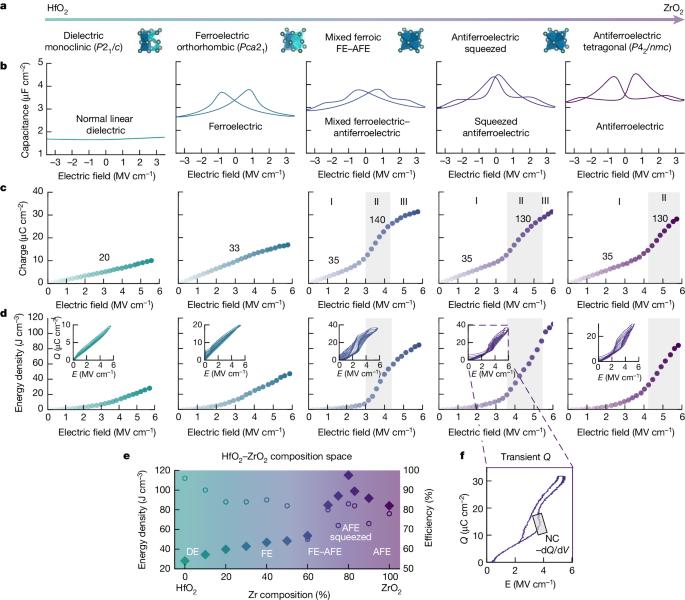Giant energy storage and power density negative capacitance superlattices
IF 48.5
1区 综合性期刊
Q1 MULTIDISCIPLINARY SCIENCES
引用次数: 0
Abstract
Dielectric electrostatic capacitors1, because of their ultrafast charge–discharge, are desirable for high-power energy storage applications. Along with ultrafast operation, on-chip integration can enable miniaturized energy storage devices for emerging autonomous microelectronics and microsystems2–5. Moreover, state-of-the-art miniaturized electrochemical energy storage systems—microsupercapacitors and microbatteries—currently face safety, packaging, materials and microfabrication challenges preventing on-chip technological readiness2,3,6, leaving an opportunity for electrostatic microcapacitors. Here we report record-high electrostatic energy storage density (ESD) and power density, to our knowledge, in HfO2–ZrO2-based thin film microcapacitors integrated into silicon, through a three-pronged approach. First, to increase intrinsic energy storage, atomic-layer-deposited antiferroelectric HfO2–ZrO2 films are engineered near a field-driven ferroelectric phase transition to exhibit amplified charge storage by the negative capacitance effect7–12, which enhances volumetric ESD beyond the best-known back-end-of-the-line-compatible dielectrics (115 J cm−3) (ref. 13). Second, to increase total energy storage, antiferroelectric superlattice engineering14 scales the energy storage performance beyond the conventional thickness limitations of HfO2–ZrO2-based (anti)ferroelectricity15 (100-nm regime). Third, to increase the storage per footprint, the superlattices are conformally integrated into three-dimensional capacitors, which boosts the areal ESD nine times and the areal power density 170 times that of the best-known electrostatic capacitors: 80 mJ cm−2 and 300 kW cm−2, respectively. This simultaneous demonstration of ultrahigh energy density and power density overcomes the traditional capacity–speed trade-off across the electrostatic–electrochemical energy storage hierarchy1,16. Furthermore, the integration of ultrahigh-density and ultrafast-charging thin films within a back-end-of-the-line-compatible process enables monolithic integration of on-chip microcapacitors5, which can unlock substantial energy storage and power delivery performance for electronic microsystems17–19. Using a three-pronged approach — spanning field-driven negative capacitance stabilization to increase intrinsic energy storage, antiferroelectric superlattice engineering to increase total energy storage, and conformal three-dimensional deposition to increase areal energy storage density — very high electrostatic energy storage density and power density are reported in HfO2–ZrO2-based thin film microcapacitors integrated into silicon.

巨型能量存储和功率密度负电容超晶格
介质静电电容器1 由于具有超快充放电能力,在高功率储能应用中颇具吸引力。除了超高速运行外,片上集成还能为新兴的自主微电子和微系统实现微型化储能设备2-5。此外,最先进的微型化电化学储能系统--微型超级电容器和微型电池--目前面临着安全、封装、材料和微细加工方面的挑战,阻碍了片上技术的发展2,3,6,为静电微型电容器的发展提供了机会。在此,我们通过三管齐下的方法,报告了在硅片上集成的基于 HfO2- ZrO2 的薄膜微电容器的创纪录高静电能量存储密度(ESD)和功率密度(PD)。首先,为了提高本征能量存储,在电场驱动的铁电相变附近设计了原子层沉积反铁电 HfO2-ZrO2 薄膜,通过负电容效应7-12 放大电荷存储,从而提高了体积静电放电(ESD),超过了最著名的线后端(BEOL)兼容电介质(115 J-cm-3)13。其次,为了增加总能量存储,反铁电超格工程14 使能量存储性能超越了基于 HfO2-ZrO2 的(反)铁电15 的传统厚度限制(100 纳米)。第三,为了提高每平方英尺的储能性能,超晶格被保形集成到三维电容器中,从而将静电释放量(areal-ESD)提高到最著名静电电容器的 9 倍(170 倍):80 mJ-cm-2(300 kW-cm-2)。这种同时具有超高能量密度和功率密度的技术克服了传统的静电-电化学储能体系中的容量-速度权衡问题1,16。此外,在与 BEOL 兼容的工艺中集成超高密度和超快充电薄膜可实现片上微型电容器的单片集成5,从而为电子微系统释放大量的能量存储和功率传输性能17-19。
本文章由计算机程序翻译,如有差异,请以英文原文为准。
求助全文
约1分钟内获得全文
求助全文
来源期刊

Nature
综合性期刊-综合性期刊
CiteScore
90.00
自引率
1.20%
发文量
3652
审稿时长
3 months
期刊介绍:
Nature is a prestigious international journal that publishes peer-reviewed research in various scientific and technological fields. The selection of articles is based on criteria such as originality, importance, interdisciplinary relevance, timeliness, accessibility, elegance, and surprising conclusions. In addition to showcasing significant scientific advances, Nature delivers rapid, authoritative, insightful news, and interpretation of current and upcoming trends impacting science, scientists, and the broader public. The journal serves a dual purpose: firstly, to promptly share noteworthy scientific advances and foster discussions among scientists, and secondly, to ensure the swift dissemination of scientific results globally, emphasizing their significance for knowledge, culture, and daily life.
 求助内容:
求助内容: 应助结果提醒方式:
应助结果提醒方式:


